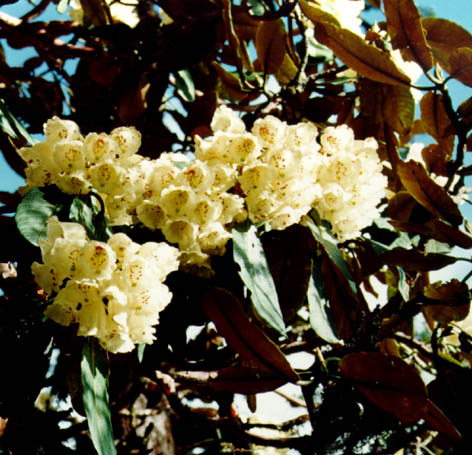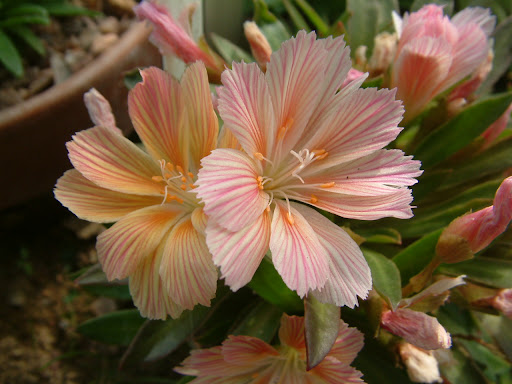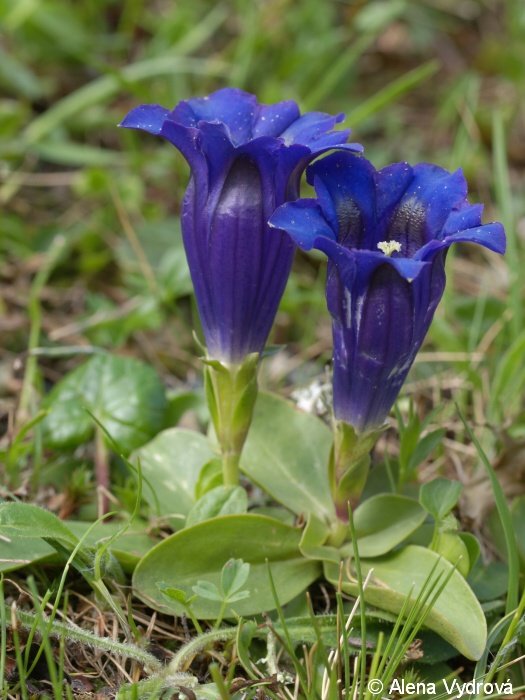I'm only allowed one from each genus, which is going to make life difficult, especially when it comes to Irises.
So, in no particular order, I'll start with the Primula. I'm a huge fan of the candelabra group but in fact, if I could just have one it's an extremely difficult little things to grow (my desert island would have a handy shady, peaty, well-drained crevice for P. sonchifolia, a very difficult Himalayan species that is just looking or excuses to die on you. I've never managed to keep it going for more than a year, as soon as the tight, round flower bud in the middle of the rossette gets wet you've had it. But when in works, it is a thing of exquisite beauty.
| Primula Sonchifolia |
I couldn't be without a Rhododendron and there are so many I could have gone for. But R. falconeri, a mighty tree-sized species with deep red bark, huge trusses of waxy, yellow flowers held among foot-long leaves which are slightly fluffy and matt on top and beautifully covered in dusky impedimentum (the brown stuff below).
 |
| Rhododendron falconeri |
 |
| Meconopsis punicea |
 |
| I. nicolai |
And so from the impossibly exotic to your local wildflower meadow (if you're incredibly lucky and European, in this case British) and the Snake's Head Fritillary, F. meleagris. This is a huge genus with some stunning, tall species festooned with chocolate bells such as F. persica and tiny, delicate little things like F. minuta but I actually think our own native beats them all with its nodding tessalated bells of prurple and white. Easy to grow in a dampish area of the garden and will naturalise where happy. Also easy from seed, perhaps the reason for its wildflower status as some argue it is actually a garden escapee but wherever it hails from, it's coming in my suitcase! The white and cream form which pops up when it feels like it is almost as beautiful.
| F.Meleagris |
If you can spell or pronounce my next choice, Paeonia mlokosewitschii (sometimes simplified to "Molly the witch" you should get one for free (it's a nightmare from seed, which loses viability quickly and permanently unless stored in damp peat in the fridge and even then a rigorous regime (which I'm halfway through) of cold/warm/cold/warm is required with the roots forming first and the leaves following some time afterwards. So to be on the safe side, I bought a mature plant too.
There's something about the simplicity of a single flower in a genus famous for its blousy hybrids that appeals, and the fact that it is the only yellow in the herbaceous group (P. lutea, a tree paeonia, is also yellow but lacks the charm of its smaller cousin. Establish it in a loamy, shady setting and leave it there: it hates being moved.
 |
| P. mlokosewitschii |
My next must-have might come as a bit of a surprise, it's an orangey-brown version of the foxglove, Digitalis ferruginea. At home in warmer, drier climes than would suit our native Digitalis purpurea, I've chosen it partly because it was one of the first oddities I grew from seed as a child but also because I find a strange beauty in its upright spikes of slightly hairy bells. Not everyone's cup of tea but I've got more than a dozen young seed-raised plants outside so someone is going to have to share my enthusiasm (or at least be polite enough to pretend to).
 |
| D. ferugunea |
Easy in a clay pot or planted at an angle – or even vertically – in a crevice in the rockery, this little gem is a ray of Californian sunshine wherever it's grown. I've seen some huge pans of single plants a foot across at alpine shows and they really take one's breath away!
 |
| L. cotyledon |
I suspect my attachment has more to do with the circumstances in which I saw it, travelling in a 4x4 along a cliff-hugging single-track dirt-track narrower than the vehicle (and I was sitting on the drop side and it was a long way down to the river below!). We spotted a yellow Incarvillea on the other side so stopped and I had to answer the call of nature so went round the other side of the vehicle and saw this amazing thing scrambling up the hillside. No seed heads, sadly, so no touchy but it was a very special moment. The Incarvillea was a stunner too.
 |
| C. Tibetana (black form) |
 |
| G. acaulis |
Oh shit, I forgot Lilies. Nepalenis probably.

Fun idea! I'll nick it,give you a name check and a link back to this blog unless you say NO!
ReplyDeleteCool choice of must haves!
Did we discuss a Digitalis seed swap on Grows on You?